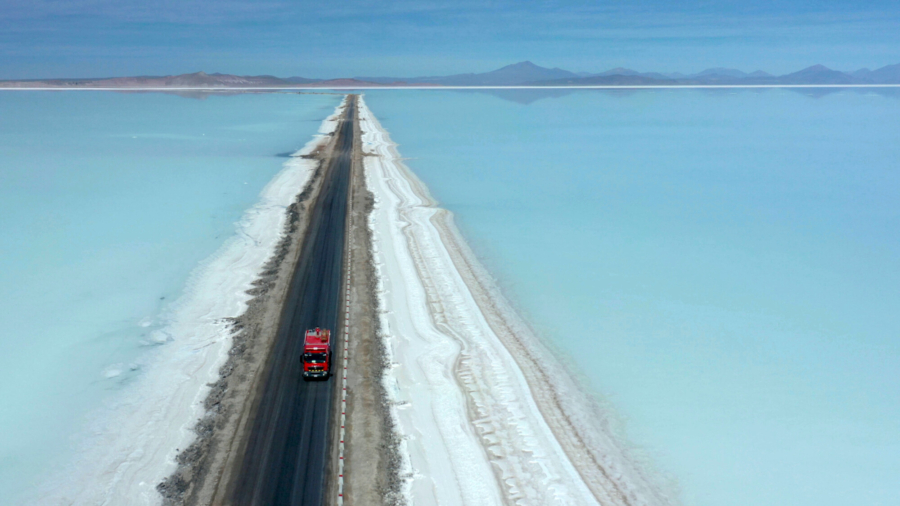A recent white paper has laid out some of the challenges in supplying minerals for any energy transition from fossil fuels, offering a timely warning for policymakers as the increased demand for electric vehicles (EVs) drives up the costs of materials used in such products.
Notably, the benchmark prices of lithium, lithium carbonate, and lithium hydroxide have rapidly increased in recent months, as detailed at Benchmark Minerals.
Hovering at just $115.80 per ton in September 2020, the benchmark price of lithium has surged to $1045.90 a ton in March 2022. That’s more than a ninefold increase.
Zach Schumacher, a North American metals price expert with Argus Media, told The Epoch Times that the costs of EVs will likely increase as a result. The estimated average transaction price for a new electric vehicle was $56,437 in November 2021, according to Kelley Blue Book.
The prices of other key minerals—including the rare-earth metal neodymium that goes into wind turbines—have also trended sharply upward in recent months and years.
“Lithium is not the only raw material directly correlated to the EV market witnessing higher costs, so parsing out precisely how much of the increased costs for vehicles in the coming months originates from lithium alone could prove fairly difficult. Nickel, stainless steel, semiconductor and labor costs are among other costs that have all also risen compared to levels from recent years,” said Schumacher, who added that the prices of consumer electronics could also rise.
“Increasingly, scholars are questioning the mineral requirements that would be needed to reach either 100 [percent] renewable or clean energy targets,” states the March report, which was authored by Phil Rossetti and George David Banks for the Citizens for Responsible Energy Solutions (CRES) Forum.
The document notes that EVs are six times as mineral intensive as vehicles that use conventional internal combustion engines, citing a report from the International Energy Agency (IEA).
Renewable energy sources are also more mineral intensive than their hydrocarbon-based alternatives. Wind turbines, for example, need roughly nine times as many minerals as natural gas plants, according to the IEA report.
“China is the dominant supplier for multiple critical minerals and is likely to remain so. In the case of minerals it does not supply—such as cobalt—China has near-monopolistic control of refining capacity through its state-owned enterprises,” the CRES Forum’s analysis states.
“Policymakers should also understand the energy security implications of policies that lean heavily on mineral-intensive products for abating greenhouse gas emissions, as scarcity of materials could raise prices as well as create dependency on foreign suppliers that could have an interest in manipulating the market.”
In addition to creating national security risks, the current situation also makes the United States culpable in using forced, or otherwise ethically questionable, labor.
One crucial solar panel input, polysilicon, is largely produced in China’s Xinjiang region, likely through the slave labor of the region’s Uyghur ethnic minority.
Likewise, much of the cobalt in lithium-ion batteries is obtained through child labor from the Democratic Republic of the Congo (DRC).
The CRES Forum report argues that the National Environmental Policy Act (NEPA) impedes domestic mining of minerals for renewable energy, even more than it impedes hydrocarbon production.
“Forty-two percent of DOE NEPA environmental assessments and environmental impact statements [are] for clean energy, transmission, or conservation efforts compared with 15 percent for fossil fuel,” it states, referencing an R Street analysis from one of the report’s co-authors, Phillip Rossetti.
A major proposed project along these lines, the Thacker Pass Lithium Mine in Humboldt County, Nevada, received its Record of Decision under NEPA in January 2021. Nevada’s Division of Environmental Protection issued mining, water, and air permits to it earlier this year.
Yet, the mine has continued to generate controversy, with Shoshone Paiute Gary McKinney writing in the Reno Gazette Journal that “our ancestors’ burial site is no place for a mine.”
The Canadian developer of Thacker Pass, Lithium Americas, has made major deals with the Chinese firm Ganfeng Lithium, including through joint ownership of the Cauchari-Olaroz brine lithium carbonate project in Argentina.
Lithium Americas’ website indicates that Ganfeng owns 46.7 percent of the project while Lithium Americas owns 44.8 percent. The remaining 8.5 percent is owned by Argentina’s state-run Jujuy Energía y Minería Sociedad del Estado (JEMSE).
Even if new domestic mines such as Thacker Pass go online, CRES Forum’s meta-analysis of three studies on the energy transition suggests that demand could outpace proven reserves of multiple key minerals, including cobalt, lithium, nickel, chromium, and zinc.
“In short, the potential mining requirements for a complete clean energy transition with existing technology is so large that it is not clear if it is economically viable to extract enough minerals to meet the needs modeled in those studies,” the report states.
In February, President Joe Biden drew attention to a range of new investments aimed at reducing the United States’ reliance on China for lithium, rare earths, cobalt, and other critical minerals.
This includes $35 million from the Department of Defense for a heavy rare earth element separation facility operated by MP Materials, owner of the country’s only rare-earth mine in Mountain Pass, California.
MP Materials is partly owned by a Chinese firm, Shenghe Resources.
“As proposed by Chinese government, and characteristic in Chinese rare earth industry, Shenghe Resources designed its equity structure on mixed ownership,” the website for the firm states, indicating that the company is partly owned by the state.
The Epoch Times has reached out to Shenghe Resources for comment.
Reuters reported in late March that Sen. Lisa Murkowski (R-Alaska) has described herself as “worried” about the Chinese stake in MP Materials.
The investments announced in February also include a $140 million Department of Energy (DoE) project to obtain critical minerals from mine waste, coal ash, and similar resources.
The CRES Forum report suggests that the challenges it describes could be mitigated by technological breakthroughs, including better approaches to carbon capture and the development of low-carbon fuels for conventional, non-electric vehicles.
It also urges the United States to sanction companies or countries that use unethical labor, arguing that such moves must be made quickly, before the country is too reliant on such minerals.
“As a major consuming market, the United States is best positioned to effect change by refusing market access to unethical suppliers,” it states.
From The Epoch Times


